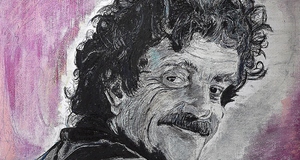Dealing with Time in an Autobiography
By
2011, Vol. 3 No. 01 | pg. 2/2 | « This allows him to move more freely in his own remembrances and give emphasis to certain events. And while Vonnegut locates himself in time with actual dates which helps to anchor his surrealistic jumps in reality, Nabokov with his realistic time consciousness dates things much differently. He instead decides “To fix correctly, in terms of time, some of my childhood recollections, I have to go by comets and eclipses, as historians do when they tackle the fragments of a saga” (Nabokov 25). Time for him was not fixed when he was younger due to calendar confusion between the Russian and Gregorian calendars, so while Vonnegut spent his youth adhering to the clock and calendar, Nabokov was floating between years. So Nabokov follows this pattern in structuring time in his work. He also collapses time in on itself, using phrases like “Several times during a summer it might happen that in the middle of luncheon,…” (Nabokov 30) and “As far back as I remember myself…” (Nabokov 33) to help the reader to see the patterns that time has formed in his life. Altogether, his use of time is used to help structure the reader around seeing the roadmap of his life, as Gusdorf would say. And Nabokov openly informs the reader of the fact that his life forms a map when he says things like “To him, in a way, I owe the ability to continue for another stretch along my private footpath which runs parallel to the road of that troubled decade” (Nabokov 29). The structure of time in his piece is helpful to the reader for actually seeing this path when they pull back with the author and observe the life.However, while these authors’ use of time is most excellent for helping the reader to observe the roadmap of the lives they are extolling, It is likewise the case the autobiography can never exhume all of that buried life making up the past. But just because all of the past cannot be presented does not mean that it is therefore absent from the autobiographical text. Such would be the case only if time (both ‘real’ time and ‘narrative’ time) were experienced as a series of nows, all of them strung on a single line. Time, however, is experienced more like the thinness of a palimpsest, as Marcel Proust knew so well – like a parchment on which layers of writing have been superimposed. Just because something is not fully visible does not mean its presence cannot be experienced (Gunn 14). There is quite a lot of the life that is hidden and the way in which an autobiography is written necessarily leaves out quite a bit of the life. It may hint at the sub-layers of the life and one way in which it does this is the fracturing of the time structures that the author is working in. T.S. Eliot illustrated this point rather eloquently in his spiritual autobiography, Four Quartets (Olney 5): Time present and time past Eliot emphasizes the futility of trying to straighten out time and allows it to intertwine and fracture just as Nabokov and Vonnegut do. For all their structuring and careful planning in the use of time, they are still finding themselves trapped in a chaos of memory and event. Nabokov recognizes this when he says “I felt myself plunged abruptly into a radiant and mobile medium that was none other than the pure element of time” (Nabokov 21). For him, time is no longer just another dimension or tool. It has become an element through which he moves, like air, and embraces and immerses him in memory. Just as when one plunges into a swimming pool, so too does one completely submerge in thoughts and feelings from the past and present. Vonnegut comments on this towards the beginning of the book while explaining the Tralfamadorian view of time: All moments, past, present, and future, always have existed, always will exist. The Tralfamadorians can look at a stretch of the Rocky Mountains, for instance. They can see how permanent all the moments are, and they can look at any moment that interests them. It is just an illusion we have here on Earth that one moment follows another one, like beads on a string, and that once a moment isgone it is gone forever (Vonnegut 34). For both Vonnegut and Nabokov, time fluctuates and flows differently in memory than it does in real life and though they attempt to structure their narratives around the time devices of a Tralfamadorian novel or a stream of recall narrative they are still dealing with the fact that time in memory does not allow for clean and neat organization because of its very nature. The palimpsest of their history is constantly affecting and being affected by the future and present of their being and as such is chaotic and arbitrary. To be sure, if one were to ask Vonnegut why he chose the order of events in his novel as opposed to a straight line narrative, he would refer the reader to a conversation when Billy is first taken by the Tralfamadorians: “‘That is a very Earthling question to ask, Mr. Pilgrim. Why you? Why us for that matter? Why anything? Because this moment simply is. Have you ever seen bugs trapped in amber?’ ‘Yes.’… ‘Well, here we are, Mr. Pilgrim, trapped in the amber of this moment. There is no why’” (Vonnegut 97). For Vonnegut, as with Nabokov, the bits of amber in their books are arranged in such a way as to make it understandable and enjoyable for the reader, but that are still just fragments of solidified tree sap and the events are the insects within. Through the consciousness of time and the manipulation and chaos stemming from that awareness, Nabokov and Vonnegut present unique narratives of their lives. Not only do they openly admit to playing with time, but they use that playfulness as a structure on which to build the entirety of their story. Vonnegut uses the Tralfamadorian novel and Nabokov uses what appears to the reader to be an arbitrary recall method, but both serve the purpose of orientating the reader to their lives and helping to build a roadmap of events. And by the very nature of time and memory, this device is unstable. As Vonnegut states, we are human and must follow the clocks, and so when the authors in which the reader is placing a good deal of trust start playing with time, the amber beads of the narrative go scattering across the floor and the reader must once more string them together. ReferencesAllen, Paula Gunn. “The Autobiographical Situation.” Autobiography: Essays Theoretical and Critical. Princeton: Princeton University Press, 1980. Print. Eliot, T.S. Four Quartets. New York: Mariner Books, 1968. Print. Gusdorf, Georges. “Conditions and Limits of Autobiography.” Autobiography: Essays Theoretical and Critical. Trans. James Olney. Princeton: Princeton University Press, 1980. Print. Nabokov, Vladimir. Speak Memory. Trans. Brian Boyd. New York: Everyman’s Press, 1999. Print. Olney, James. “Autobiography and the Cultural Moment: A Thematic, Historical, and Bibliographic Introduction.” Autobiography: Essays Theoretical and Critical. Princeton: Princeton University Press, 1980. Print. Renza, Louis A. “The Veto of the Imagination: A Theory of Autobiography.” Autobiography: Essays Theoretical and Critical. Princeton: Princeton University Press, 1980. Print. Vonnegut, Kurt. Slaughterhouse-Five. New York: Dial Press, 2005. Print.
Suggested Reading from Inquiries Journal
Inquiries Journal provides undergraduate and graduate students around the world a platform for the wide dissemination of academic work over a range of core disciplines. Representing the work of students from hundreds of institutions around the globe, Inquiries Journal's large database of academic articles is completely free. Learn more | Blog | Submit Latest in Literature |














